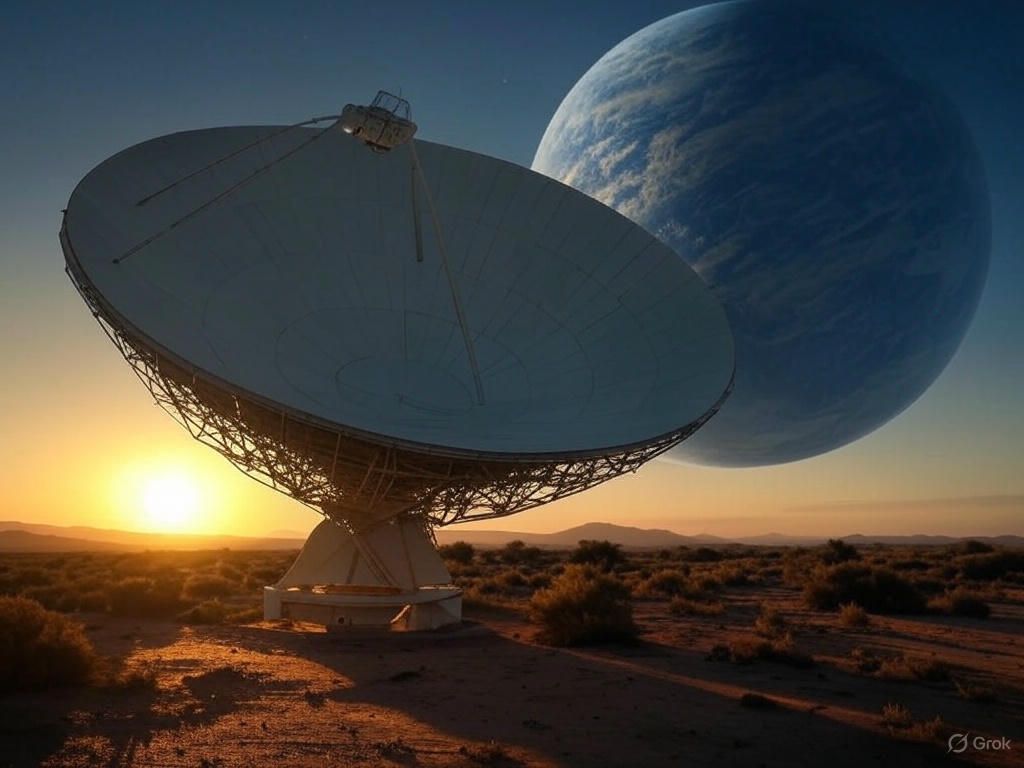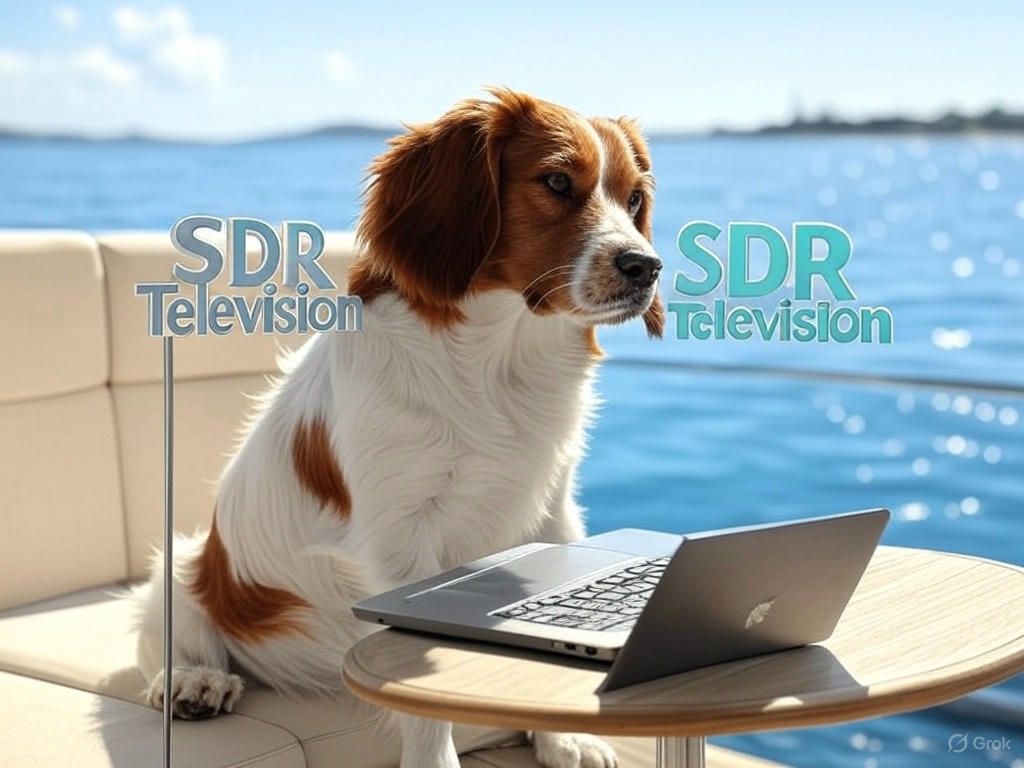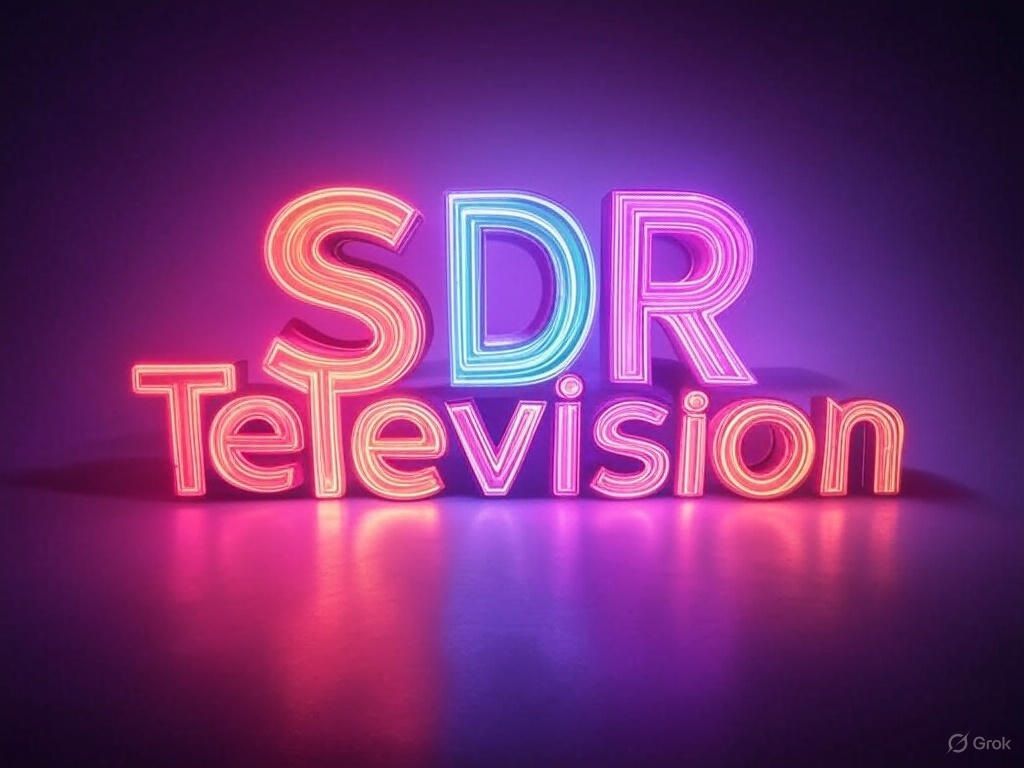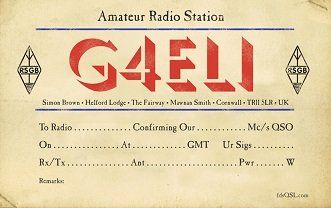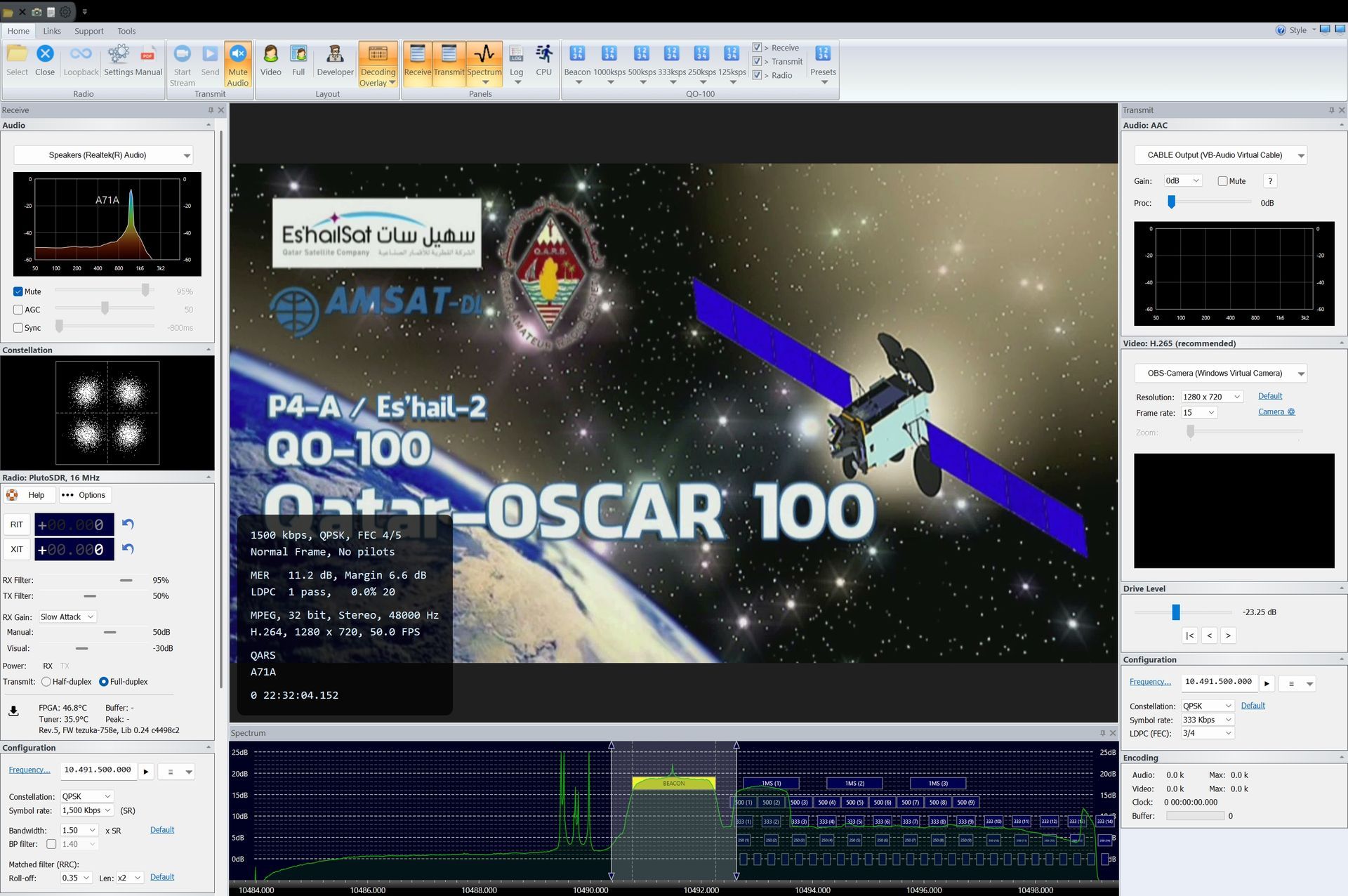
DATV for QO-100 (Es'hail-2)
This is a new project, the general goals:
- Learn about the DVB-S2 and DVB-S2X standards:
- Create a signed, standalone Windows application supporting DATV transmit and receive using DVB-S2. No need for any extra hardware or software other than the usual: microphone, webcam, SDR.
Early Manual
Here's an early manual in PDF form, date February 6th 2025.
DVB Standards
- EN 300 421 V1.1.2 (1997-08) Digital Video Broadcasting (DVB); Framing structure, channel coding and modulation for 11/12 GHz satellite services.
- EN 302 307-1 V1.4.1 (2014-11) Digital Video Broadcasting (DVB); Second generation framing structure, channel coding and modulation systems for Broadcasting, Interactive Services, News Gathering and other broadband satellite applications; Part 1: DVB-S2.
- EN 302 307-2 V1.3.1 (2021-07) Digital Video Broadcasting (DVB); Second generation framing structure, channel coding and modulation systems for Broadcasting, Interactive Services, News Gathering and other broadband satellite applications; Part 2: DVB-S2 Extensions (DVB-S2X).
Application
- Using Microsoft Media Foundation for all video-related processing as this is the current state of the art for Windows.
- Support the Analog Devices Pluto, other SDRs such as LimeSDR later.
- Code will be highly optimised, target hardware is the Intel Processor N100 at 330 symbol rate.
- Remove the need for extra hardware such as the MiniTiouner and software such as VLC Player.
Installation
- A signed kit, all required redistributable packages included.
- What you'll need:
- Windows 10 or higher, 64-bit x86 architecture, AVX2 required (so no Core2DUO support).
- Microphone and Webcam.
- SDR such as ADALM Pluto using the standard firmware.
Timeframe
These are very provisional dates:
- QPSK receive Q3 2024
- QPSK transmit Q1 2025
- First kits for general use Q2 2025
DVB-T2
If this project is successful then support for DVB-T2 (Digital Video Broadcasting – Second Generation Terrestrial) will be considered.
Downloads
Download links are in the blog entries, sorted by date.


DATV
Digital Amateur Television (DATV) is a form of amateur television transmission that involves the broadcasting of digital pictures using the DVB broadcast standards. This technology allows radio amateurs to transmit and receive high-quality video and audio over a wide range of frequencies allocated for radio waves. DATV transmissions are characterized by their use of digital modes, such as DVB-S and DVB-T standards, which offer superior picture quality and require less spectrum bandwidth compared to traditional FM-ATV transmissions[1][3].
Amateur television enthusiasts engage in various aspects of video production, editing, transmission, and reception of television signals. The use of digital television modes has proven to be robust and efficient for amateur television transmissions, with the ability to generate signals across a broad frequency range from 70 MHz to 3.4 GHz[1]. Additionally, reduced bandwidth transmissions known as Reduced-Bandwidth TV (RB-TV) are being experimented with, using symbol rates like 500 KS, 333 KS, 250 KS, 125 KS, and 66 KS[1].
Receiving digital amateur TV is commonly done using devices like the MiniTiouner, which interfaces a satellite TV receiver module with a PC running specialized DATV reception software[1]. On the other hand, transmitting digital ATV can be achieved through software like DATV Express or hardware setups like the BATC Portsdown software on a Raspberry Pi with a LimeSDR Mini[1].
DATV has been instrumental in various applications such as providing video coordination for public service events, natural disasters, and even retransmitting NASA TV by amateur stations in the United States[3]. The technology has opened up opportunities for experimentation, pleasure, and public service events within the amateur radio community.
In Australia, DATV operates on the PAL standard for analogue TV and uses frequencies like 445.5MHz for digital TV signals (DVB-T)[4]. Regular broadcasts and groups like the REAST DATV Experimenters Group facilitate engagement with digital amateur television through scheduled programs and live streams[4].
Overall, Digital Amateur Television represents an exciting intersection of technology and amateur radio that enables enthusiasts to explore video transmission within the realm of radio waves.
Citations:
[1] https://rsgb.org/main/technical/amateur-television/
[2] https://www.youtube.com/watch?v=bdmyEEiYzi4
[3] https://en.wikipedia.org/wiki/Amateur_television
[4] https://www.reast.asn.au/special-interest-groups/amateur-tv/
[5] https://www.youtube.com/watch?v=xpiQwbSwjtQ
DVB-S2: Enhancing Satellite Communications
DVB-S2, which stands for Digital Video Broadcasting Satellite Second Generation, is a standard that significantly improves satellite communication capabilities. It provides specifications for framing structure, channel coding, modulation systems, and spectrum efficiency[3]. Some key features and advantages of DVB-S2 include:
- Applications: DVB-S2 supports a wide range of applications such as newsgathering, HDTV broadcast services, internet access, cellular backhauling, government and defence networks[3].
- Efficiency: DVB-S2 is 30% more efficient than its predecessor, DVB-S, allowing for a wider range of applications and maximizing satellite resources value[1].
- Flexibility: The standard offers adaptive coding and modulation based on channel conditions, various modulation and code rates (MODCODs), and signal constellations optimized for different channel types[3].
- Compatibility: DVB-S2 is compatible with MPEG-2 and MPEG-4 coded TV services, ensuring seamless integration with existing technologies[3].
The transition from DVB-S to DVB-S2 is driven by the need for higher data rates to support services like HDTV and 3D-HDTV. While the upgrade process involves replacing or upgrading set-top boxes, the benefits of DVB-S2 in terms of efficiency and application versatility make it a crucial advancement in satellite communications technology[1].
Citations:
[1] https://en.wikipedia.org/wiki/DVB-S2
[2] https://www.etsi.org/technologies/dvb-s-s2
[3] https://www.mathworks.com/discovery/dvb-s2.html
[4] https://www.rohde-schwarz.com/uk/technologies/satellite-broadcast/dvb-s2/dvb-s2-technology/dvb_s2_technology_55598.html
[5] https://www.everythingrf.com/community/dvb-s2-vs-dvb-s2x
Advantages of DVB-S2 over DVB-S
DVB-S2, the second generation of Digital Video Broadcasting Satellite, offers several advantages over its predecessor, DVB-S:
- Improved Forward Error Correction (FEC) Performance: DVB-S2 provides 2 to 2.5 dB better FEC performance compared to DVB-S, enhancing error correction capabilities[1].
- Higher Spectral Efficiency: DVB-S2 offers a 30% increase in spectral efficiency, allowing for higher data rates over the same frequency bandwidth compared to DVB-S[1][2].
- Enhanced Modulation Schemes: DVB-S2 supports advanced modulation schemes like Low-Density Parity Check (LDPC) forward error correction (FEC), Variable Code Modulation (VCM), and Adaptive Code Modulation (ACM), enabling more efficient data transmission[4].
- Support for New Technologies: DVB-S2 is compatible with last-generation technologies and supports features like Variable Code Modulation and Enhanced Modulation Schemes up to 32 APSK, enhancing overall performance and adaptability[3][5].
- Application Versatility: DVB-S2 caters to a wide range of applications including Direct-to-Home (DTH), enterprise VSAT, trunking, mobility, cellular backhaul, large-scale data content distribution, and electronic news gathering, making it a versatile choice for various satellite communication needs[5].
Overall, the transition from DVB-S to DVB-S2 represents a significant advancement in satellite communication technology, offering improved performance, efficiency, and compatibility with modern broadcasting requirements.
Citations:
[1] https://www.rfwireless-world.com/Terminology/Difference-between-DVB-S-and-DVB-S2.html
[2] https://en.wikipedia.org/wiki/DVB-S2
[3] https://www.mwrf.com/community/contributors/article/21849293/whats-the-difference-between-dvbs2-and-dvbs2x-standards
[4] http://www.satmagazine.com/story.php?number=1955130098
[5] https://www.everythingrf.com/community/dvb-s2-vs-dvb-s2x
DVB-S2X: Enhancing Satellite Television Broadcasting
DVB-S2X is a digital satellite television broadcast standard that was standardized by the DVB Project in March 2014 as an optional extension of the DVB-S2 standard. This extension offers significant efficiency gains of up to 51% compared to DVB-S2. Some key improvements in DVB-S2X include higher order modulation schemes (64/128/256APSK), smaller roll-off factors of 5%, 10%, and 15%, improved filtering for smaller carrier spacing, and channel bonding to combine different carriers for increased efficiency in 'Direct-To-Home' (DTH) applications[1][3].
Main Features of DVB-S2X:
- Efficiency gains up to 51% compared to DVB-S2.
- Higher order modulation schemes (64/128/256APSK).
- Smaller roll-off factors (5%, 10%, 15%).
- Improved filtering for smaller carrier spacing.
- Channel bonding for increased efficiency in DTH applications.
- Supports UHDTV services with bonding channels to enhance statistical multiplexing efficiency[1].
Use Cases and Applications:
DVB-S2X finds applications in various sectors including Direct to Home (DTH), Contribution, VSAT, and DSNG. It supports very low carrier-to-noise ratios down to -10 dB, making it suitable for mobile applications like marine, aerospace, trains, etc. The system also incorporates features like more granularity of modulation and coding modes, smaller filter roll-off options, new constellation options, channel bonding up to three channels, and more scrambling options for critical co-channel interference situations[3][4].
In summary, DVB-S2X represents a significant advancement in satellite television broadcasting technology, offering enhanced efficiency, improved modulation schemes, and a range of features that cater to the evolving needs of the broadcasting industry.
Citations:
[1] https://en.wikipedia.org/wiki/DVB-S2X
[2] https://dvb.org/?standard=second-generation-framing-structure-channel-coding-and-modulation-systems-for-broadcasting-interactive-services-news-gathering-and-other-broadband-satellite-applications-part-2-dvb-s2-extensions
[3] https://www.mwrf.com/community/contributors/article/21849293/whats-the-difference-between-dvb-s2-and-dvb-s2x-standards
[4] https://dvb.org/?standard=dvb-s2x-implementation-guidelines
[5] https://www.iis.fraunhofer.de/en/ff/kom/satkom/dvb-s2x_technology.html


